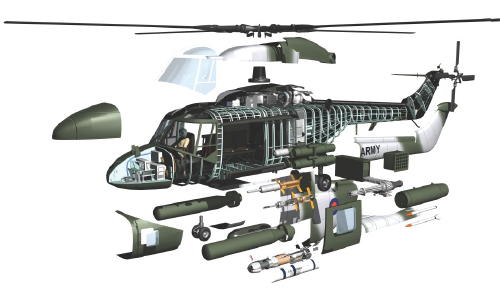Diecast Military Helicopters
Diecast Combat Rotorcraft
 It wasn't all that long ago that it was next to impossible to build a sizable, pre-assembled military helicopter collection. Now, with new players such as Hobby Master, Amercom, and Italeri entering the hobby, along with stalwarts such as Corgi, Unimax and Armour Collection, aviation enthusiasts can finally cobble together a truly respectable fleet of rotary wing aircraft from across the globe. With more new product on the drawing board, the future looks bright and continues to gather momentum with each passing year.
It wasn't all that long ago that it was next to impossible to build a sizable, pre-assembled military helicopter collection. Now, with new players such as Hobby Master, Amercom, and Italeri entering the hobby, along with stalwarts such as Corgi, Unimax and Armour Collection, aviation enthusiasts can finally cobble together a truly respectable fleet of rotary wing aircraft from across the globe. With more new product on the drawing board, the future looks bright and continues to gather momentum with each passing year.
Combat Helicopters: A Brief History
Military helicopters are helicopters owned and used by military forces. They can be found in a variety of roles in different militaries of which the tactical airlift mission is the most common. Some militaries also possess attack helicopters and specialist helicopters for specific missions include but are not limited to battlefield reconnaissance, CSAR, casevac, airborne command post, anti-submarine warfare and minesweeping. Specialist helicopters are operated only by the best funded and most capable militaries.
Attack helicopters are armed helicopters used in the anti tank and close air support roles. The first of the modern attack helicopters was the Vietnam era AH-1 Cobra, which pioneered the now classic format of pilot and weapons officer seated in tandem in a narrow fuselage, chin mounted guns and disposable armament of rockets and missiles mounted on stub wings. To enable to find and distinguish their targets modern attack helicopters are equipped with very capable sensors such as the Longbow mm radar system, this makes such attack helicopters useful reconnaissance assets.
Military transport helicopters are used in places where the use of conventional aircraft is impossible. For example the military transport helicopter is the primary transport asset of US Marines deploying from LHDs and LHA. The landing possibilities of helicopters are almost unlimited, and where it is impossible, such as in densely packed jungle, troops may deploy by roping.
Transport helicopters are operated in three main classes: assault, medium and heavy. Assault helicopters are usually the smallest of the transport types, and designed to move an infantry section and their equipment. Helicopters in the assault role are generally armed for self protection both in transit and for suppression of the landing zone. This armament may be in the form of door gunners, or the modification of the helicopter with stub wings and pylons for the carriage of missiles and rocket pods. For example the Sikorsky S-70 fitted with the ESSM (External Stores Support System) and the Hip E variant of the Mil Mi-8 can carry as much disposable armament as dedicated attack helicopters. The assault helicopter can be thought of as the modern successor to the military glider.
Not all militaries are able to operate a full range of transport helicopters so the medium transport is probably the most common specialist transport type. Medium transport helicopters are generally capable of moving up to a platoon of infantry and are capable of being able to transport towed artillery or light vehicles either internally or slung below the copter. Examples include the unarmed versions of the Mil Mi-8, the Super Puma and the CH-46 Sea Knight.
Heavy lift helicopters are the most versatile and expensive of the transport types, currently limited in service to the CH-53 Sea Stallion the related CH-53E Super Stallion, CH-47 Chinook, Mil Mi-26 and
Aerospatiale Super Frelon. Capable of lifting up to 80 troops and moving small AFVs (usually as slung loads but also internally). These helicopters operate in the tactical transport role in much the same way as small fixed wing turboprop airlifters. The lower speed, range and increased fuel consumption of helicopters being more than compensated by their ability to operate anywhere.
For the most part helicopters in the Light Observation Helicopter class have replaced aircraft such as the Taylorcraft L-2 and Fieseler Fi 156, in the scout (reconnaissance) and observation (airborne Artillery observer/FAC) roles. Examples of the observation helicopter include the Aerospatiale Gazelle in UK service and the OH-58 Kiowa. At first such helicopters were usually unarmed for fear that pilots would be too aggressive and actively attack targets they should have been observing. However the recent trend is for the creation of the armed scout role, initially with gun and rocket pods, with modern light weight systems allowing the carriage of ATGWs and AAMs of the fire-and-forget variety. (Courtesy: Wikipedia)
|







 It wasn't all that long ago that it was next to impossible to build a sizable, pre-assembled military helicopter collection. Now, with new players such as Hobby Master, Amercom, and Italeri entering the hobby, along with stalwarts such as Corgi, Unimax and Armour Collection, aviation enthusiasts can finally cobble together a truly respectable fleet of rotary wing aircraft from across the globe. With more new product on the drawing board, the future looks bright and continues to gather momentum with each passing year.
It wasn't all that long ago that it was next to impossible to build a sizable, pre-assembled military helicopter collection. Now, with new players such as Hobby Master, Amercom, and Italeri entering the hobby, along with stalwarts such as Corgi, Unimax and Armour Collection, aviation enthusiasts can finally cobble together a truly respectable fleet of rotary wing aircraft from across the globe. With more new product on the drawing board, the future looks bright and continues to gather momentum with each passing year.